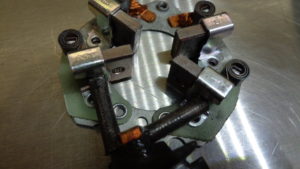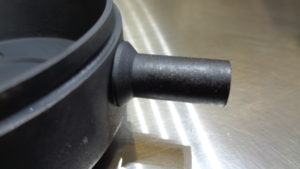The backplate on the 83388-09 motor is quite often in terrible condition.
This is the area where the manufacturer really didn’t quite finish the job.
We have found an unusually high amount of road dirt and water contaminant in the area. This is the case with at least 50% of the many motors that we have previously rebuilt. Also, it seems that if the vehicle were ever ridden in the rain, small amounts of rain water enter this portion of the motor and cause corrosion and rust.
Rain water will not short out a low voltage DC current. But, what it will do, is cause rust and corrosion. And this is the worst place to have rust because it houses the brushes and the brush holder assembly. The brush holder itself consists of a metal frame with four square guides that the brushes are mounted in. Behind the brushes are the springs which are needed to keep the brushes pressed firmly against the commutator.
As rust and corrosion form on the brush holder frame and the brush guides, it becomes a restriction to brush tension and travel. Brushes no longer are free to travel in the guides. Also rust and corrosion can form very quickly on brush tension springs. 

This is an extremely volatile condition for any DC electric motor and this is one of the major problems with the 83388-09. The design is that of an automotive starter BUT is being used as an electric motor. Amperage surges (caused by pollutants, corrosion, overuse, or any type of malfunction) during periods of usage will cause irreparable damage to other major components, such as the armature.
Over amperage surge is a sure bet when the armature fails to turn, because when a starter fails to turn, it’s a dead short. It is at this millisecond, that the battery surges to full amperage capacity.
The solenoid closes, the surge flows through the solenoid contacts, through the brushes, and directly onto the commutator (copper part of the armature). This is now a junk armature. At the very least : it creates a burn mark on that particular bar of the commutator. Then each time that bar passes a brush during future uses, more and more damage occurs to that bar, until finally…the ever popular scenario known as a “dead spot” on the starter.
 Corrosion and rust is often compounded exponentially by the lack of air circulation. Moisture can even condense from thermo cycle. As the hot air from the engine or usage cools, moisture is condensed. Not having proper ventilation in the brush area quickly becomes a slippery slope to a junk motor. The early versions of the 83388-09 did not have ventilation. However, both types of the later versions have a vent tube. It allows fresh air in and out as needed, but keeps water splash out. This breather tube occurs in millions of GM type starters in the market today. It is proven, in fact, to work very well. If your 83388-09 does not have a breather tube, we will install it for you.
Corrosion and rust is often compounded exponentially by the lack of air circulation. Moisture can even condense from thermo cycle. As the hot air from the engine or usage cools, moisture is condensed. Not having proper ventilation in the brush area quickly becomes a slippery slope to a junk motor. The early versions of the 83388-09 did not have ventilation. However, both types of the later versions have a vent tube. It allows fresh air in and out as needed, but keeps water splash out. This breather tube occurs in millions of GM type starters in the market today. It is proven, in fact, to work very well. If your 83388-09 does not have a breather tube, we will install it for you.NEW INFO ON THE BACK PLATES
The back bushing to the motor is subject to the most revolutions in the motor, and constantly in direct wear relationship with the armature during every use. This bushing is one of the shortest bushings (in relation to the diameter) in automotive history. It is borrowed directly from, an older Nissan Maxima which was not one of the greatest starters of its era, but was not not in duty cycle nearly as much as the same bushing in a motor atmosphere. However, we HAVE solved the problem, and have achieved 4-5 year old longer lifetime expectancy.